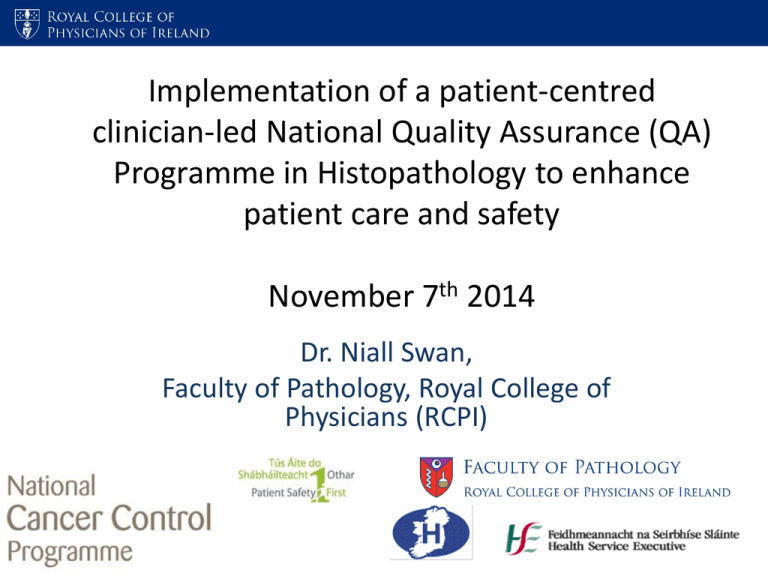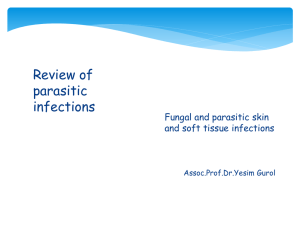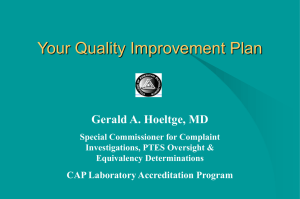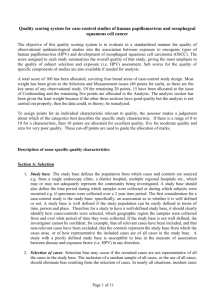Presentation-10-Dr-Niall-Swan
advertisement

Implementation of a patient-centred clinician-led National Quality Assurance (QA) Programme in Histopathology to enhance patient care and safety November 7th 2014 Dr. Niall Swan, Faculty of Pathology, Royal College of Physicians (RCPI) WHAT IS HISTOPATHOLOGY? WHAT DO HISTOPATHOLOGISTS DO? HISTOPATHOLOGY MICROBIOLOGY PATHOLOGY / LABORATORY MEDICINE BLOOD SCIENCES -HAEMATOLOGY -BLOOD TRANSFUSION -CHEMISTRY -IMMUNOLOGY Histopathology Diagnosis Cycle Patient Journey Patient requires diagnosis Clinician decides on test Specimen taken from patient by Surgeon/Clinician Clinician orders test Specimen labelled Specimen transported to Lab Specimen examined by Pathologist with naked eye Patient Treating Clinician Surgeon/Clinician Surgical Nurse Patient begins treatment Pathologist Specimen preparation requires a high degree of skill, patience and accuracy. Complex electronic equipment, computers, and instruments are Medical Scientist employed, each with limits of precision Specimen embedded into wax or resin support Multi disciplinary team Patient informed of diagnosis & treatment plan Specimen cut into smaller samples Any diagnosis is made under conditions of uncertainty and the opinion of the Pathologist is a judgment of specimen information in the context of all other information available interpreted against his or her knowledge and experience. Patient treatment plan determined Report reviewed as part of full patient case multi disciplinary review Report sent to Clinician Pathologist completes report Specimen examined by Pathologist under microscope Pathologist makes opinion on diagnosis Specimen mounted onto slides Specimen stained Tissue Specimens in Laboratory Sample labelling Embedding Cassette labelling Microtomy Microscopic analysis and interpretation TEST CYCLE Zarbo et al. Arch Pathol Lab Med 2005;129:1237-45 Background to the QA Programme Need for Formal Measures of Quality Assurance In Histopathology High Profile cancer misdiagnosis cases in 2007 & 2008 No formal measures to reassure the public that Irish Histopathology Laboratories provide a quality service to the highest international standards No set national standards or benchmarks for key aspects of diagnostic service External Laboratory Accreditation • ISO 15189 standards for medical laboratories (NSAI / INAB) • Technical competence requirements and management system requirements necessary to consistently deliver technically valid results • Faculty of Pathology had concerns clinical aspects of service not fully addressed by the accreditation process Vision of National QA Programme A patient centred Quality Assurance framework within each department, which routinely reviews performance and drives improvement, in key quality areas against intelligent targets. Aim of the National QA Programme in Histopathology Patient centred, Pathologist / Laboratory-Led programme Establish a national QA framework that ensures patient safety and enhancement of patient care with timely, accurate and complete diagnoses and reporting Provide evidenced based assurance to the public of the quality of Irish diagnostic services Programme Model 1.Guidelines 2. ICT 3. Schedule Process Initiation Design Rollout Measure (2008) (2009-2010) (2011-2012) (2013) 1. Engagement 2. Definition 3. Governance 4. Working Group 1.Training & support 2.Phased Implementation 3. National Database Control Scope – All Laboratories 8 Private Laboratories North East– 2 Departments West –7 Departments Dublin – 14 Departments Mid Leinster – 1 Department South/SE – 3 Departments Governance Overview Steering Committee Members: HSE Quality & Patient Safety, National Cancer Control Programme , HSE ICT, HSE service management, Independent Hospitals Association of Ireland (IHAI), Dept of Health, Faculty, RCPI Observer: HIQA Faculty of Pathology Clinical Working Group Programme Management Quality & Clinical Care, RCPI HSE ICT Local Hospital Participant Teams ** ** Note Data owner is the local unit & governance of the data is with that unit’s local, regional and national governance structures 15 Summary of Guidelines Monitor Key Indicators Inter-institutional review % Agreement Intradepartmental Consultation % Cases Frozen Section Correlation % Concordance, % Deferral, TAT Cytological/histological correlation % Discordant, % False positive, % False negative Retrospective review (Focused real time / report completeness) % Agreement / % Completeness Multi disciplinary Team meetings % Agreement, % of total cases discussed Non-conformance reporting No. of non-conformances, Clinical impact External Quality Assessment List of Schemes, results Turn around Time TAT by case type Addendum Reports Supplementary, corrected, amended Critical Diagnoses Reporting No. of cases reported directly to clinician Data Collection & Extraction Data extracted • QA activity data coded into LIS • Extract progam developed by LIS Vendors Data collected Data transferred • MRN Encrypted before data leaves hospital Data encrypted • Data transferred to central repository: NQAIS Atlas - framework 1 big table Analysis A4 portrait Many parameters Horizontal display Numbers (Ct, %, median ...) Comparison Trend Each parameter – 1 row Intuitive at a glance User – dates, comparator Report 1. Query Log into system from Parameters your desktop Analysis Results Language: Clinical > business Simple Concise NQAIS (National Quality Assurance Intelligence System) Report Preview Programme Model November 2014 1.Guidelines 2. ICT 3. Schedule Process 1.Data Collation & Analysis Initiation Design Rollout Measure (2008) (2009-2010) (2011-2012) (2013) 1. Engagement 2. Definition 3. Governance 4. Working Group 1.Training & support 2.Phased Implementation 3. National Database Control 1.National Quality Benchmarks (KQI) 2.Embedding Benchmarking Methodology used 1. Review and investigate the National QA Reports from NQAIS-Histopathology 2. Review national and international benchmarks relating to each Quality Activity 3. Define excellent and achievable standards for each Quality Activity, where applicable Objectives • Keep it simple • Compare to international standards • Avoid setting unachievable targets but also ensure targets set are credible • Use the national data gathered • Tailor each one to clinical practice in Ireland National NQAIS Report 2013 National NQAIS Report 2013 National NQAIS Report 2013 National NQAIS Report 2013 Intradepartmental Consultation Percentage of Intradepartmental Consultation Completed per month - All Hospitals 8.0% 7.0% 6.0% 5.0% 4.0% 3.0% 2.0% 1.0% 0.0% Percentage IntraD Completed Achievable target Minimum target National Histology Workload 2013 Type Specimens Blocks No. (Cases) 566,912 (357,249) 950,791 Total Stains 2,030,484 Routine H&E 1,448,313 (319,245) Extra H&E 224,022 (47,266) IHC stains 248,920 (35,491) Frozen Section stains 6,757 (1,482) Key to success Established governance structure Communication & Consultation Clinical Leadership and Engagement Collaboration – HSE, NCCP, HSE ICT, IHAI Successful implementation Real Time Data and ICT support Achievements A completely unique national programme • Across public and private laboratories • Across 8 different Laboratory Information Systems (LIS) • Across small and large hospitals with different levels of resourcing Development of a central repository NQAIS-Histopathology Collection of national data for Histopathology • Never before collected on this scale Confidence in the data to understand in real time our workload and extent of quality activities Ability for us to set national targets based on our data Programme Benefits Improved patient care and public confidence Less need for large scale look backs QA data for local service enhancement Identification of good practice Identification of areas requiring development Improved communication between institutions leading to strategic links/networks Development of National Targets for QA activities Model for other National QA Programmes (Radiology, Endoscopy) Next Steps On-going review of national data quality Propose and set further National Q marks Gather and share best practice (Annual Workshops) Promote use of NQAIS reports at hospital level Continuous quality improvement through use of NQAIS reports www.rcpi.ie for National Implementation & Data Reports Acknowledgements Ms. Mairead Guinan, Mr. Philip Ryan, Prof. Conor O’ Keane, Prof. Kieran Sheahan, Dr. Julie McCarthy, Dr. Jennifer Martin, Mr. Seamus Butler, Mr. Brian Dunne, Dr. Howard Johnson, Dr. Mary Hynes, Ms. Louise Casey, Mr. John Magner, Mr. Leo Kearns







